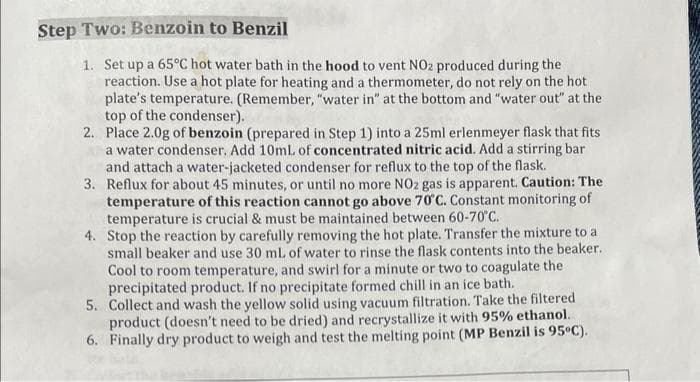Step Two: Benzoin to Benzil 1. Set up a 65°C hot water bath in the hood to vent NO2 produced during the reaction. Use a hot plate for heating and a thermometer, do not rely on the hot plate's temperature. (Remember, "water in" at the bottom and "water out" at the top of the condenser). 2. Place 2.0g of benzoin (prepared in Step 1) into a 25ml erlenmeyer flask that fits a water condenser. Add 10mL of concentrated nitric acid. Add a stirring bar and attach a water-jacketed condenser for reflux to the top of the flask. 3. Reflux for about 45 minutes, or until no more NO2 gas is apparent. Caution: The temperature of this reaction cannot go above 70°C. Constant monitoring of temperature is crucial & must be maintained between 60-70°C. 4. Stop the reaction by carefully removing the hot plate. Transfer the mixture to a small beaker and use 30 mL of water to rinse the flask contents into the beaker. Cool to room temperature, and swirl for a minute or two to coagulate the precipitated product. If no precipitate formed chill in an ice bath. 5. Collect and wash the yellow solid using vacuum filtration. Take the filtered product (doesn't need to be dried) and recrystallize it with 95% ethanol. 6. Finally dry product to weigh and test the melting point (MP Benzil is 95°C).
Step Two: Benzoin to Benzil 1. Set up a 65°C hot water bath in the hood to vent NO2 produced during the reaction. Use a hot plate for heating and a thermometer, do not rely on the hot plate's temperature. (Remember, "water in" at the bottom and "water out" at the top of the condenser). 2. Place 2.0g of benzoin (prepared in Step 1) into a 25ml erlenmeyer flask that fits a water condenser. Add 10mL of concentrated nitric acid. Add a stirring bar and attach a water-jacketed condenser for reflux to the top of the flask. 3. Reflux for about 45 minutes, or until no more NO2 gas is apparent. Caution: The temperature of this reaction cannot go above 70°C. Constant monitoring of temperature is crucial & must be maintained between 60-70°C. 4. Stop the reaction by carefully removing the hot plate. Transfer the mixture to a small beaker and use 30 mL of water to rinse the flask contents into the beaker. Cool to room temperature, and swirl for a minute or two to coagulate the precipitated product. If no precipitate formed chill in an ice bath. 5. Collect and wash the yellow solid using vacuum filtration. Take the filtered product (doesn't need to be dried) and recrystallize it with 95% ethanol. 6. Finally dry product to weigh and test the melting point (MP Benzil is 95°C).
Chapter76: Reaction Methods
Section: Chapter Questions
Problem 4P
Related questions
Question
What is the purpose of steps 2,3 and 4

Transcribed Image Text:Step Two: Benzoin to Benzil
1. Set up a 65°C hot water bath in the hood to vent NO2 produced during the
reaction. Use a hot plate for heating and a thermometer, do not rely on the hot
plate's temperature. (Remember, "water in" at the bottom and "water out" at the
top of the condenser).
2. Place 2.0g of benzoin (prepared in Step 1) into a 25ml erlenmeyer flask that fits
a water condenser. Add 10mL of concentrated nitric acid. Add a stirring bar
and attach a water-jacketed condenser for reflux to the top of the flask.
3. Reflux for about 45 minutes, or until no more NO2 gas is apparent. Caution: The
temperature of this reaction cannot go above 70°C. Constant monitoring of
temperature is crucial & must be maintained between 60-70°C.
4. Stop the reaction by carefully removing the hot plate. Transfer the mixture to a
small beaker and use 30 mL of water to rinse the flask contents into the beaker.
Cool to room temperature, and swirl for a minute or two to coagulate the
precipitated product. If no precipitate formed chill in an ice bath.
5. Collect and wash the yellow solid using vacuum filtration. Take the filtered
product (doesn't need to be dried) and recrystallize it with 95% ethanol.
6. Finally dry product to weigh and test the melting point (MP Benzil is 95°C).
Expert Solution
This question has been solved!
Explore an expertly crafted, step-by-step solution for a thorough understanding of key concepts.
This is a popular solution!
Trending now
This is a popular solution!
Step by step
Solved in 2 steps

Knowledge Booster
Learn more about
Need a deep-dive on the concept behind this application? Look no further. Learn more about this topic, chemistry and related others by exploring similar questions and additional content below.Recommended textbooks for you

EBK A SMALL SCALE APPROACH TO ORGANIC L
Chemistry
ISBN:
9781305446021
Author:
Lampman
Publisher:
CENGAGE LEARNING - CONSIGNMENT


EBK A SMALL SCALE APPROACH TO ORGANIC L
Chemistry
ISBN:
9781305446021
Author:
Lampman
Publisher:
CENGAGE LEARNING - CONSIGNMENT
